Search
Search for "click":
(Click here to search this entire website for "click" with Google.)
 |
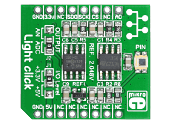
|
|
Light Click is the add-on board which features the PD15-22CTR8 PIN photodiode, providing an effective and easy way to measure ambient light intensity. It also features the MAX6106 voltage reference and MCP3201 ADC with SPI interface. Measured ambient light intensity is sent as an analog or digital signal to the main board microcontroller. Light Click communicates through mikroBUS SPI (MISO, SCK, CS) and AN lines. The PD15-22C-TR8 is a high photosensitive light sensor with fast response time. An SMD jumper allows the user to select whether the board will be powered with a 3.3V or 5V power supply. |
|
|
|
 |
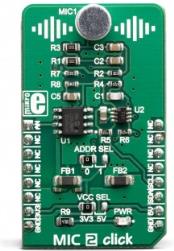
|
|
MIC 2 click is equipped with a small electret microphone, accompanied by a suitable pre-amplifying circuit. The small electret microphone is not capable of providing sufficient line-level output; therefore, the pre-amp has to be used. The pre-amp circuit consists of a dual op-amp and a digitally controlled potentiometer IC. Thanks to the AD5171, it is possible to control the feedback loop gain of the MCP6022 op-amp over the I2C interface, in 64 discrete steps. The AD5171 digital potentiometer IC can lock-out its wiper by means of OTP fuse bit: once locked, it will permanently retain the programmed value.
MIC 2 click is supported by a mikroSDK compliant library, which includes functions that simplify software development. This Click board™ comes as a fully tested product, ready to be used on a system equipped with the mikroBUS™ socket.
|
|
|
|
 |
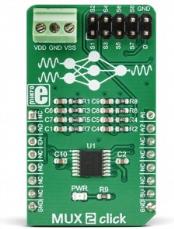
|
|
MUX 2 click is a Click board™ that switches one of the eight inputs to one output. It employs the MUX508, a modern CMOS analog multiplexing integrated circuit, produced by Texas Instruments. This IC can be powered with both dual power supplies, ranging from ±5V to ±18V, and single power supplies, ranging from 10V to 36V. It offers rail-to-rail operation, allowing the input signal to swing up (and down) to the voltage of the power supply, with no distortion. Features such as the break-before-make switching action, electrostatic discharge protection up to 2kV, low on-resistance and low input current leakage, make this circuit a perfect solution for various switching applications, operating with both unipolar and bipolar signals.
It comes in the package which also includes the mikroSDK™ software and a library with all the functions. The Click board™ comes as a fully tested and approved prototype, making it a reliable device ready to use on the development board.
|
|
|
|
 |
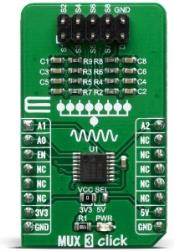
|
|
MUX 3 Click is the general purpose multiplexer which offers multiplexing one input channel to eight single-ended output channels. Given the TMUX1208 wide operating supply options from 1.08 V to 5.5 V and support of bidirectional I/O signals, its allowing you use in a broad array of applications ranging from personal electronics to building automation applications such as: Heating, Smoke Detectors, Ventilation, Air Conditioning, Battery-Powered Equipment, Consumer Audio, etc.
MUX 3 Click board™ is supported by a mikroSDK compliant library, which includes functions that simplify software development. This Click board™ comes as a fully tested product, ready to be used on a system equipped with the mikroBUS™ socket.
|
|
|
|
 |

|
|
NFC 3 Click is a compact add-on board that contains an NFC transceiver for contactless communication at 13.56MHz. This board features the PN5180A0HN, a highly integrated high-performance full NFC Forum-compliant frontend from NXP Semiconductors. The PN5180A0HN utilizes an outstanding modulation and demodulation concept for different contactless communication methods and protocols. It is fully compliant with many Reader/Writer standards (ISO 14443A/B, ISO 15693, ISO 18092, and more), alongside support for reading all NFC tag types (type 1, 2, 3, 4A, and 4B). Besides the SPI host interface, it also features high RF output power to drive an antenna etched on the PCB directly, besides its tuning circuit, at high efficiency. This Click board™ represents an ideal solution for rapidly integrating NFC technology into any custom application.
NFC 3 Click is supported by a mikroSDK compliant library, which includes functions that simplify software development. This Click board™ comes as a fully tested product, ready to be used on a system equipped with the mikroBUS™ socket.
|
|
|
|
 |

|
|
NFC 4 Click is a compact add-on board that contains an NFC transceiver for contactless communication. This board features the ST25R3916, a multi-purpose NFC transceiver supporting passive peer-to-peer functionality and NFC card-emulation mode, as well as NFC reader operation from STMicroelectronics. It features high RF output power to directly drive an antenna etched on the PCB, alongside its tuning circuit, at high efficiency. The ST25R3916 also represents an EMVCo reader fully compliant with ISO 14443A/B, ISO 15693, ISO 18092, Felica, and NFC Forum standards. Thanks to the ST25R3916, this Click board™ provides all the features designers need to quickly market and comply with relevant NFC specifications. This Click board™ represents an ideal solution for rapidly integrating NFC technology in any custom application.
NFC 4 Click is supported by a mikroSDK compliant library, which includes functions that simplify software development. This Click board™ comes as a fully tested product, ready to be used on a system equipped with the mikroBUS™ socket.
|
|
|
|
 |
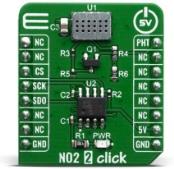
|
|
NO2 2 Click is a gas sensor Click board™, equipped with the MiCS-2714, a compact metal oxide (MOS) sensor. This sensor reacts to the presence of nitrogen dioxide (NO2) and hydrogen (H2). Its impedance changes as a result of a catalytic reaction, allowing it to be used in a voltage divider configuration. This voltage can be sampled by an accurate A/D converter (ADC), allowing data to be read directly over the I2C interface. The MiCS-2714 sensor itself is a robust sensor, which can be used in harsh environment for gas leakage detection, in breath checking applications, early fire detection, etc.
NO2 2 click is supported by a mikroSDK compliant library, which includes functions that simplify software development. This Click board™ comes as a fully tested product, ready to be used on a system equipped with the mikroBUS™ socket.
|
|
|
|
 |
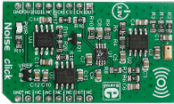
|
|
Noise click is a mikroBUS add-on board with noise detecting circuitry. It enables you to set a noise detection threshold for alarm systems, environmental monitoring or data logging. When the volume of ambient sound reaches the set threshold, an interrupt is triggered.
The most important parts of the circuit are the microphone, an RMS-to-DC converter, two dual rail-to-rail Input/Output 10 MHz operational amplifiers, and a 12-bit digital-to-analog converter (DAC).
The 12-bit DAC provides the reference voltage - the noise threshold - for the comparator. You set the exact level through the SPI interface. The threshold should be configured through trial and error (4096 discrete values to select from).
Beside SPI, EN and OUT pins provide additional functionality.
The board works on a 3.3V power supply. |
|
|
|
 |

|
|
PIC clicker is a compact and cost-effective board, featuring the PIC18F47J53 microcontroller as well as a mikroBus socket for easily connecting "click" accessory boards (3.3V I/O levels). It also features a USB connector, two LEDs and two push buttons, mikroProg programming connector and an expansion header. The board comes pre-loaded with a fast USB HID bootloader. |
|
|
|
 |
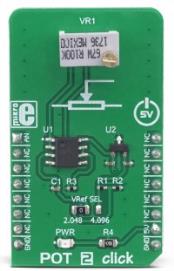
|
|
POT 2 click is a Click board™ with the accurate selectable reference voltage output. By utilizing a multi-turn precision potentiometer, this Click board™ can provide very accurate voltage output on the AN pin of the mikroBUS™. POT 2 click is also equipped with the SMD jumper, which allows the maximum reference voltage to be selected between two typically used values: 2.048V or 4.096V. Using a rail-to-rail buffering operational amplifier which provides constant input and output impedance, this Click board™ is an ideal solution when accurately controlled voltage reference is required.
POT 2 click is supported by a mikroSDK compliant library, which includes functions that simplify software development. This Click board™ comes as a fully tested product, ready to be used on a system equipped with the mikroBUS™ socket.
|
|
|
|
 |
|
<< First
< Previous
Next >
|
|

